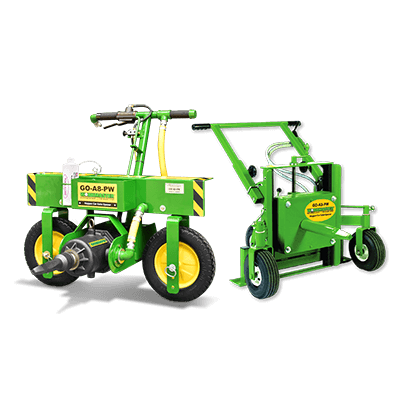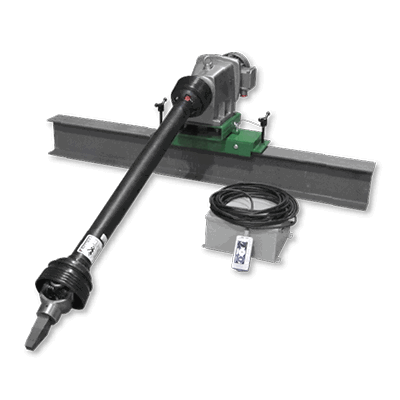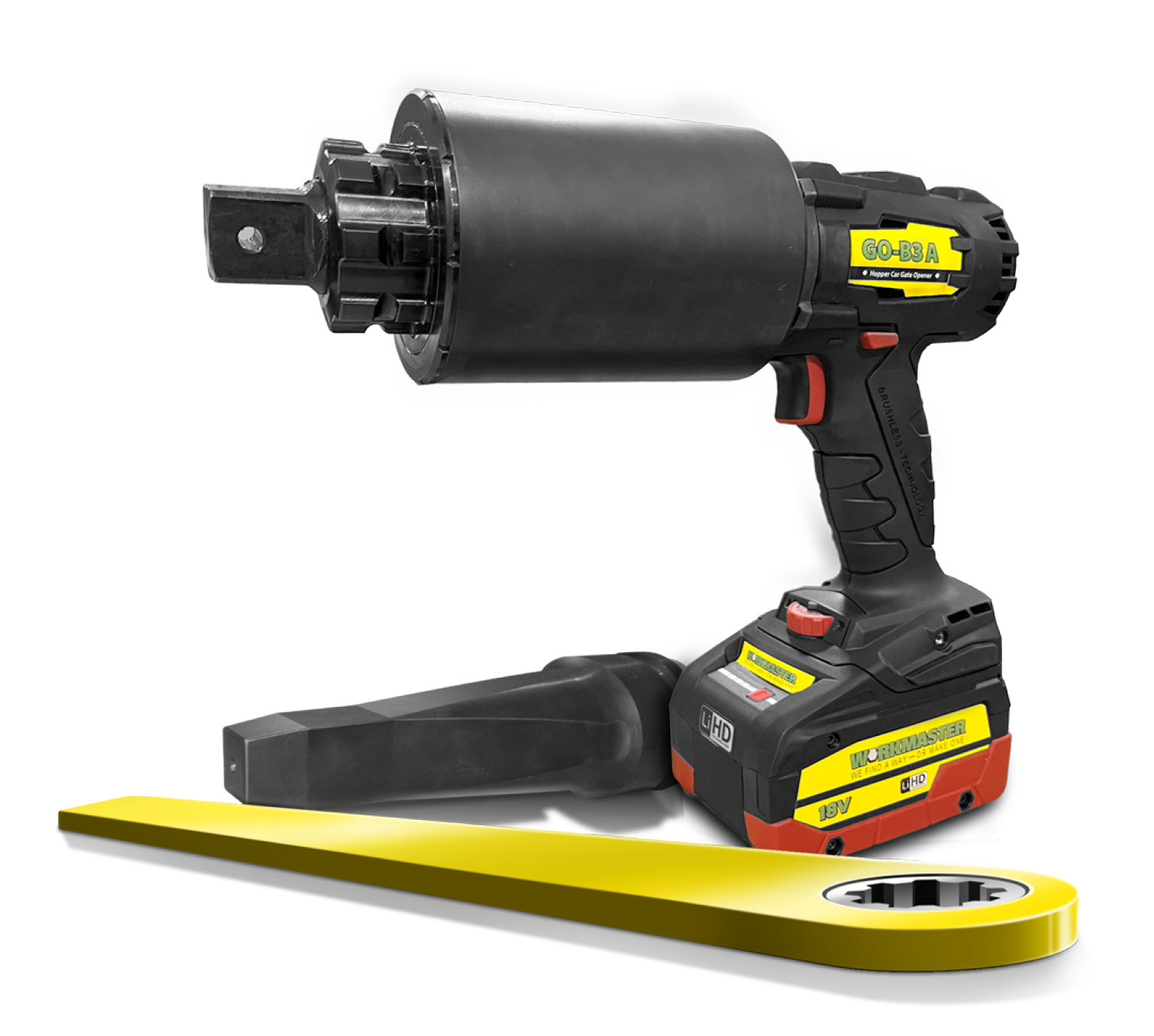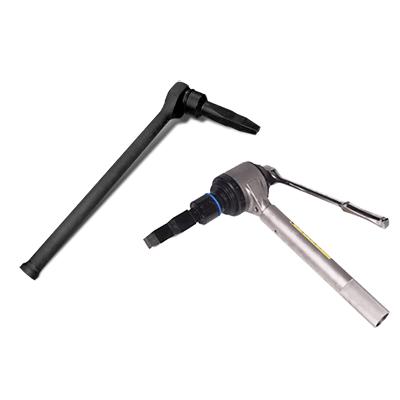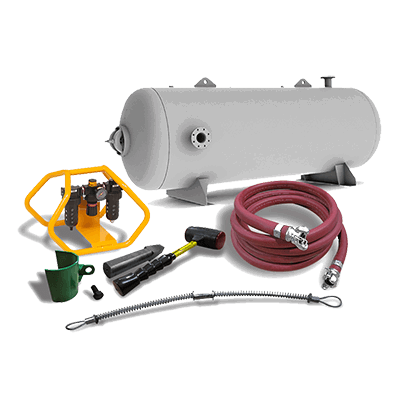Railcar Gate Openers & Accessories
Hopper bottom railcar unloading sites are notoriously dangerous and dirty. A hopper bottom railcar (hopper car) is a type of railcar used to transport loose bulk commodities such as coal, ore, grain, and similar freight. The process of unloading products from these types of railcars, whether covered hopper cars (equipped with a roof) or open hopper cars (open-top freight railcars), can be excessively labor-intensive. The unloading products available at AIRMATIC will make unloading these railcars more efficient and productive, as well as safer. Powered tools such as railcar gate openers and railcar vibrators will make the process of unloading powder and bulk solid materials from hopper cars faster and safer by reducing the manual labor that is always inefficient — and often dangerous.
Read more »
Railcar unloading often forms a bottleneck at the very beginning of the processing of powders or bulk solids. First, the railcar gates are jammed shut, and opening them can be a challenging, time-consuming chore. Pry bars, come-a-longs, chain falls, and sometimes even torches are required. Next comes the task of unloading the railcar.
Either the railcar materials won’t flow at all, or the flow is intermittent. Sledgehammers, rods, air lances, and vibrators are all employed. Too often, all are ineffective on the material you’re attempting to unload. Finally, as the material flows from the railcar, dust envelops the site. The wind carries it to nearby buildings or the surrounding neighborhood. Now, OSHA and the EPA are potentially involved in your operation.
Fortunately, it doesn’t have to be like this. We can provide you with the railcar unloading equipment that will make your site safer and more productive than it’s ever been. Talk with us about railcar gate openers and railcar vibrators, truck trap openers and truck vibrators, and railcar pocket-to-undertrack conveyor unloaders. We're ready to share our more than 75 years of bulk material handling expertise and eager to help you eliminate a few problems.
CloseTypes of Railcar Gate Openers & Accessories
Pneumatic Railcar Gate Openers
Experience the power of air with our pneumatic railcar gate openers, mounted on wheeled carts for convenience. Choose between manual height adjustment or pneumatic-controlled lift adjustment, along with pneumatic control of both pivot wheels. Renowned for their speed, power, efficiency, safety, user-friendliness, and robust construction, our pneumatic gate openers set the industry standard.
VIEW PRODUCTSElectric Railcar Gate Openers & Accessories
Effortlessly open railcar gates with our electric-powered openers, featuring a rolling carriage for smooth travel as it aligns with the railcar’s capstan. Controlled by a remote pendant, these openers offer instant forward/reverse action and allow manual adjustment of a telescoping drive shaft at angles up to 50° vertical or horizontal.
VIEW PRODUCTSBattery-Powered Railcar Gate Openers
Opt for portable power with our battery-operated railcar gate openers, designed for torque-controlled performance. Capable of delivering up to 3000 ft-lbs. of torque, these openers handle gates ranging from easy to moderately difficult to open with ease and reliability.
VIEW PRODUCTSManual Railcar Gate Openers
When budget constraints or sites with minimal hopper car traffic are criteria, our manual railcar gate openers step in to deliver practical solutions. Designed in both torque-multiplier and ratchet-wrench styles, these compact and portable tools offer economical yet dependable performance, serving as ideal backup units as well.
VIEW PRODUCTSRailcar Gate Opener Accessories
Enhance and customize your gate openers with our wide range of accessories. From horizontal and vertical air receiver tanks to capstan drive fittings, universal joints, air hose assemblies, capstan repair swage kits or capstan renew slide-on fittings, exhaust diverter kits, FRLs, retainer pins, ball valves, and gate opener protective covers for outdoor storage, we offer everything you need to optimize your gate-opening setup.
VIEW PRODUCTSCommon Industries:
Industries that rely on railcars to move bulk materials into or out of their plants include:
- Feed & Grain
- Cement
- Food
- Fracking
- Chemical
- Plastics
- Aggregate
- Coal
Practicing Safety in Railcar & Bulk Trailer Unloading
It’s important to always follow all safety practices when operating railcar and trailer unloading tools and equipment. Some of the more important practices to follow include these: Use correct techniques, maintain proper balance, and wear the right protective gear. Missteps regularly lead to worker injuries and can cause damage to equipment as well. Read more »
Another factor to focus on for proper safety is the weather and other natural elements. Slippery weather, such as rain or snow, can lead to injuries or equipment damage. Frozen components may lead to jammed slide gates and trailer traps, and windblown bulk solids can cause significant dust/visibility problems.
Finally, worker productivity will also affect safety at the unloading site. An employee who has worked too long and has become overtired can cause serious on-site accidents. Ensuring that employees are not over-worked, are taking hydration breaks in hot weather, and are using the right tools will help avoid lost time due to injuries or equipment damage resulting from misjudgments by fatigued workers at busy unloading sites. Close

Talk with a WORKMASTER Expert now.
